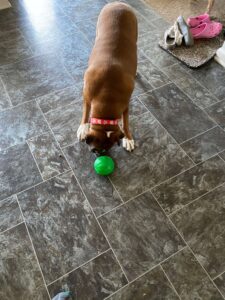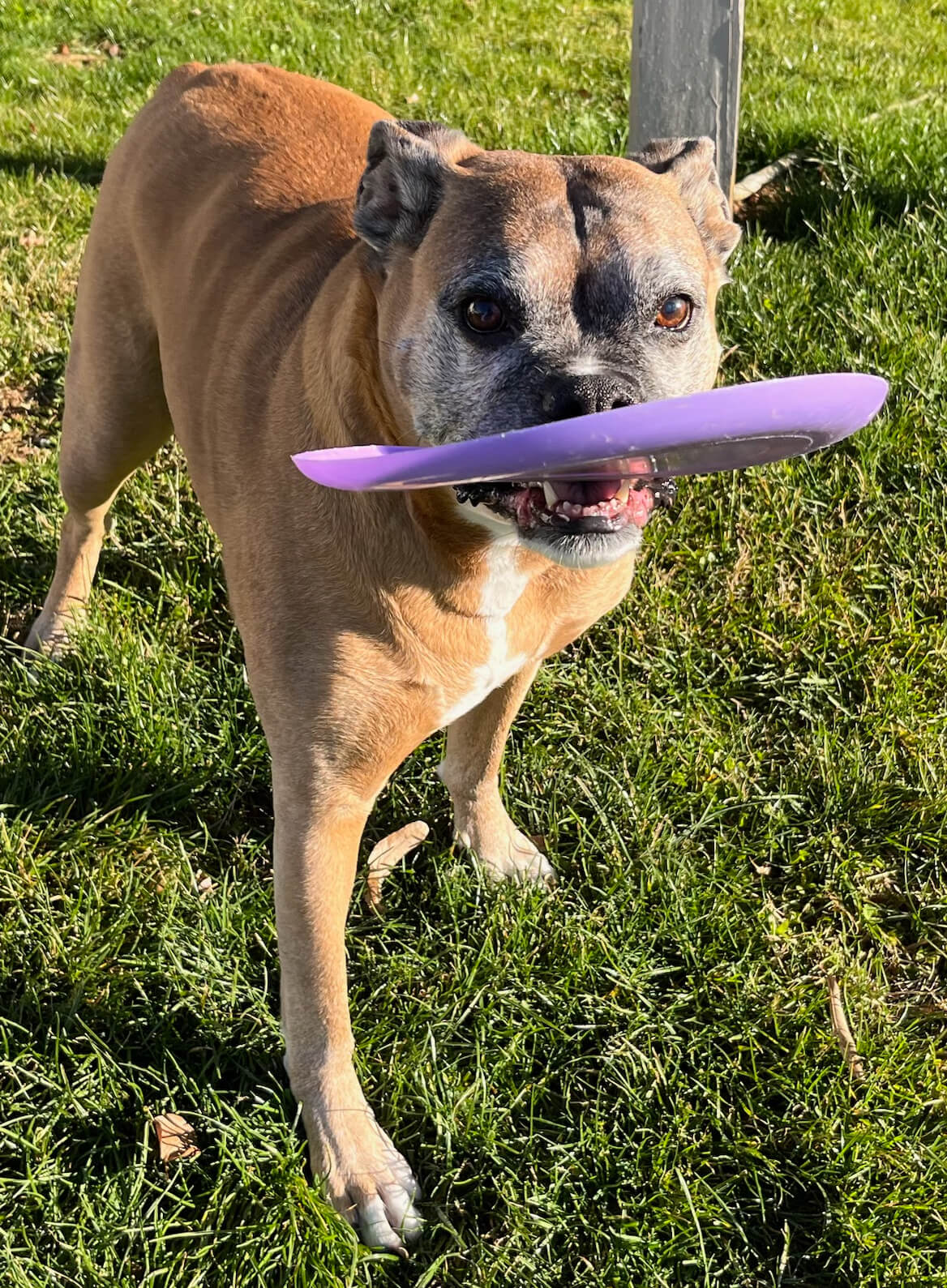This post contains affiliate links. See our Affiliate Disclosure Statement page for more details.
Table of Contents
Boxer Dog Exercises
Boxer Dog exercises should be tailored to meet your Boxer’s exercise and mental stimulation requirements during each life stage: Puppy, Adult, and Senior dog.
Boxers are a high-energy dog breed that requires appropriate amounts of exercise and mental stimulation to prevent destructive behaviors (i.e, chewing, digging, etc.)
3 Types Of Boxer Dog Exercises for Each Life Stage
Boxer Dog Puppy
- A scheduled walk of no more than 20 min per day
- Too much exercise at an early age can cause joint and bone issues later in life
- Play toys for mental stimulation
- Obedience and Socialization Training
Adult Boxer Dog
- Boxers should have a minimum of 90 minutes with the ideal being 2 hours of walking per day.
- This should be split into several walks during the day and allow time for your boxer to explore their environment.
- Off-leash time to run in a secure area. Boxers have the instinct to chase prey based on their breeding history and chase small animals if left to run in an unsecured area.
- Mental Stimulation – These reinforce the Boxers’ natural instincts and include chasing (frisbee or fetch), agility (obstacle course, tunnels), jumping (Flirt Pole) activities, and sniffing mats.
Senior Boxer Dogs
- Reduce the frequency and duration of senior Boxer dog’s walks based on their capabilities. An hour per day should be sufficient to meet their exercise needs.
- Off-leash time in a secure area to allow them to explore or play at their own pace.
- Mental Stimulation – includes activities including puzzles and sniff mats, puzzle blankets, and hide and seek games.
For additional information on exercises and mental stimulation for Boxers read our posts
- 7 Best Common Calorie Burning Exercises for Boxer Dogs and Owners
- 9 Best Ways to Mentally Stimulate Your Boxer Dog For A Happy Obedient Companion
Boxer Dog Exercises – Boxer Owner Data on Exercise Frequency and Duration
Are Boxer owners providing adequate exercise for their Boxer Dogs?
A UK study entitled Variation in Activity Levels Amongst Dogs of Different Breeds: Results of a Large Online Survey for UK Dogs owners, by Pickup, et.al published in the Journal of Nutrition Science with 12,314 Pedigree Dogs of which 218 were Boxers produced the following data.
Owners were asked how often they exercised their dogs outside the home. The results are listed in the table below.
Exercise Frequency
Breed/Total % | Never | 1-3 Times/week | 4-6 Times/Week | 1/day | Greater Than 1x/day |
Boxer 218 (1.3%) | 0 (0%) | 9 (4%) 0 (0%) | 17 (8%) | 71 (31%) | 121 (56%) |
As the data illustrates, a vast majority of Boxer Owners are ensuring their Boxer Dog gets the appropriate frequency of exercise to meet their needs.
Owners were then asked how long they exercise their Boxer Dogs (Duration). The results are listed in the table below.
Exercise Duration
0-10 min | 11-30 min | 30-60 min | Greater Than 1 Hour | Off Lead in Public |
2 (1%) | 57 (26%) | 119 (55%) | 40 (18%) | 162 (74%) |
The data also suggested that the size of the dog played a key factor in the duration of exercise.
A positive correlation was noted that medium and large dog owners would exercise their dogs for more than 30 min compared to smaller dogs. The breakdown in dogs receiving 30 min of exercise was
- Small dogs (1,369 – 55%)
- Medium Dogs (3,484 – 72%)
- Large Dogs (3,752 – 75%)In addition Working Dogs, which encompasses Boxer dogs (555 – 64%) were least likely to be let off the lead in Public.
Table 1 below provides a summary of exercise requirements for each life stage for your Boxer Dog.
Life Stage | Type of Exercise | Duration |
Boxer Puppy | Walking | 20 min |
Boxer Adult | Walking Off-leash - Running & play Time | 2 hours (divided into several walks per day)
|
Boxer Dog Senior | Walking | 1 hour per day (divided walks) |
If you are limited in the amount of time you have to walk your Boxer, and are looking for pet walking services in your area, visit Rover.com for qualified dog walkers. Click on the Banner below for additional information.
Table 2 summarizes mental stimulation Activities for each life stage for your Boxer dog.
Life Stage | Types of Mental Stimulation | Activities |
Boxer Puppy | Obedience & Socialization Training | Socialization - Exposing your Boxer to different environments (Vet, petting & touching by strangers, parks)**
|
Adult Boxer | Off-leash Chasing Agility Jumping Sniffing | Frisbee or Throw Toy Obstacle course Fetch Pole or Throw Toy Sniff or puzzle mats, treat balls |
Senior Boxer | Sniffing | Puzzle or Sniff mat |
** Boxer puppies should be cleared by the veterinarian to go out in public once they have received the required vaccinations.
Boxer Dog Exercises – Puppies

Walking A Boxer Puppy Important Points
- Boxer Puppy should only have one scheduled walk per day lasting no more than 20 minutes.
- Too much exercise for a boxer puppy at an early age can retard growth and lead to joint issues later in life.
- While you want to introduce and socialize the puppy to its new environment, it’s essential that the Boxer puppy has had the appropriate vaccinations and is cleared by the veterinarian.
Boxer Dog Exercises – Mental Stimulation for Boxer Puppies
- A variety of puppy toys can mentally stimulate your puppy while simultaneously providing needed exercise and as a means to release pent-up energy.
- The following types of toys will help mentally stimulate your Boxer Puppy.
Squeaky Toys –
- Use the squeaky toys during a game of fetch to keep the puppy’s attention while playing and reinforce their instinctive skill for chasing while helping to tire them out.
- A great option for tugging and pulling games
We recommend the goDog Checkers Sitting Pig Squeaker Dog Toy, Pink from Chewy.com.
Treat Balls –

- Treat Balls can be used to reinforce your Boxer Puppy’s urge to sniff and smell while stimulating the brain to find the hidden treat.
- Treat balls also provide a reward for good behavior.
We recommend the Starmark Treat Dispensing Chew Ball Tough from Chewy.com. We have been using this product with our boxers for several years. They are easy to load and very durable.
Rope toys
- Rope toys are a great way to interact with your boxer puppy in a game of tug-of-war.
- It reinforces their instinctive behavior for tugging and pulling while simultaneously exercising most of their major muscle groups.
Obedience and Socialization Training
Once your Boxer puppy has completed their required series of vaccines, it’s essential to provide socialization and obedience training.
Socialization Training
Socialization training allows your puppy to interact with other people and dogs to prevent your boxer puppy from developing aggressive behaviors towards people and other dogs.
Socialization training involves exposing your boxer puppy to family, friends, and strangers and allowing them to pet your puppy so they become accustomed to being touched.
The second aspect of socialization training involves taking your Boxer puppy to public places such as parks, kids’ sporting events, etc., and allowing them to interact with the environment and other dogs in a safe supervised manner so they feel comfortable around other dogs and people.
Obedience training
Boxers are a high-energy breed and need obedience training to channel their energy so they don’t develop destructive behaviors and are difficult to control.
Basic commands that should be taught to your Boxer Puppy are
- Sit
- Down – Boxers can get excited and want to jump up on people to get attention. Teaching them this down command will prevent this unwanted behavior.
- Stay
Obedience and socialization training can be done by enrolling you and your Boxer in classes outside the home, hiring an in-home dog trainer, or providing the training yourself with validated training programs.
Brain Training for Dogs is a validated program that can help your boxer learn obedience and socialization skills at home. Click on the link below for more information
Rover.com also provides private virtual one-on-one dog training via their virtual Good Pup dog training program. Click the link for more information on Rover.com Good Pup Training Program
Boxer Dog Exercises – Adult Boxer Dogs
Walking and Adult Boxer Dog Key Points
- Adult Boxers should be walked a minimum of 90 minutes per day with the target being 2 hours. This can be divided into several walks per day.
- Boxer dogs are Brachycephalic dogs, meaning their skull is compressed. The anatomy of the Boxer’s skull and the positioning of the airways make it difficult to breathe in hot weather, particularly in areas with high humidity.
- When walking a Boxer in Hot weather make sure to find shaded areas for them to rest and cool down and provide plenty of water to prevent dehydration.
- Boxers are also sensitive to very cold weather, due to being a short-haired breed with large muscle mass and very little fat. Caution should be used when walking in cold weather. Keep the walks short to prevent hypothermia.
Boxer Dog Exercises – Off Leash Time
- Off-leash time should be done in a secure area 2-3 times per week.
- During the off-leash time, your boxer should be allowed to run to help expend their pent-up energy while simultaneously strengthening all of their muscle groups.
- Off-leash activities should include those that test their natural instincts developed throughout their breeding history. These include
- Chasing – (Frisbee or Throw Toy) – simulates chasing prey
- Jumping – (Flirt Pole) – used to simulate their jumping on prey or intruders when they served as guard dogs.
- Tugging and Pulling (Rope Toys) – Simulate pulling and tugging at prey as well as intruders.
- Smell/Sniffing – hide and seek game with treats, treat balls, puzzle mats, etc. to test their sense of smell and their ability to find the prey (reward).
For additional information on ways to mentally stimulate your Boxer during play and off-leash time, read our article 9 Best Ways to Mentally Stimulate Your Boxer Dog For A Happy, Obedient Companion.
Recommendations for Play & Mental Stimulation Toys for Boxer Dogs
Disney Pumbaa Hide & Seek Plush Squeaky Dog Toy at Chewy for mental stimulation
ChuckIt Fumble Fetch at Cherrybrook for fetching
Boxer Dog Exercises for Senior Boxer Dogs
Walking a Senior Boxer Dog Key Points
- Senior Boxers require about an hour of walking split over several sessions.
- Let your Senior Boxer set the pace and end the walk when they appeared to be tired out.
- Boxer seniors still think they are younger and will continue to walk and play which can be detrimental to their joints and health. Set specific time limits on walking and outdoor play to protect their joints.
- Senior Boxers are particularly sensitive to very hot and cold weather so it’s important to limit their walks during these times.

Our Senior Boxer Duke, who is almost 10 years old, still loves to chase and jump for frisbees and play tug of war. Unfortunately, he has Osteoarthritis in his front shoulder and excessive outdoor play causes him to limp for several days even on pain medications.
Therefore we limit his play time to protect him from himself. We always tease him and say “You’re going to hurt your bad wheel” if you play too hard.
Mental Stimulation for Senior Boxers
- Mental stimulation activities should limit the chasing and jumping activities of their younger counterparts.
- Focus on skill games with them like hide and seek, puzzle mats, or learning tricks as they have a penchant for learning and pleasing their owners.
- Treat balls are a great way to provide a reward while at the same time challenging them to find the treats.
Summary
- Boxer dog exercises should be tailored to meet the exercise requirements at each stage of the Boxer’s life; Puppy, Adult, and Senior
- Exercise should be multi-faceted and include walking, off-leash time, and mental stimulation.
- Boxer puppies should be exposed to socialization and obedience training so that they don’t develop aggressive and destructive behaviors.
- Boxer puppies should limit their exercise in the early stages to reduce the potential for joint damage and slowing growth.
- Weather should be an essential consideration at each stage of the Boxer’s life. They are sensitive to both hot and cold temperature extremes.
Use these recommendations to develop an exercise program for your Boxer and enjoy the bonding time whether it is walking or off-leash time.
A well-exercised and mentally stimulated Boxer dog will be a happy and healthy Boxer.
Enjoy the time you spend walking and playing, you will both be better for it.
References:

Discoverboxerdogs.com are Mary and Chris Kustanbauter. We reside in Red Lion, PA with our two Boxers, Duke and Katie, who are both rescue dogs. We have been working with Adopt A Boxer Rescue for the past 17 years and have adopted 5 Boxers from this fine organization. To learn more visit our Home, Boxer Dog Family, and Blogs Pages Visit us on social media on Facebook – All About Boxers, Instagram, and Pinterest.

